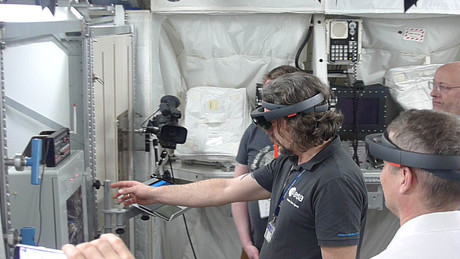Augmented reality for space station maintenance

The VTT Technical Research Centre of Finland is leading an international project to develop a new augmented reality (AR) tool for the European Space Agency (ESA). In the future, it is envisaged that astronauts will be able to use this tool to perform maintenance tasks and real-time equipment monitoring in the demanding conditions of space.
The two-year EdcAR project (Engineering data in cross platform AR) seeks to find a solution to the challenges involved in maintenance and the provision of work instructions, which have been an issue for more than a decade. Since maintenance and other work tasks in space are critical, they must be carried out without errors and at the right time. Preparing for these requires in-depth practising, which involves coordinating the activities of various experts. Since astronauts’ time is extremely valuable, their tasks and maintenance instructions must be unambiguous.
With this in mind, the EdcAR project developed an AR system intended to improve the performance of manual tasks in the frame of the space industry. The system is expected to reduce mistakes, speed up tasks and improve the clarity of the instruction by the use of AR technology.
The major benefit is the real-time location of the point requiring maintenance. This information is transmitted to the astronaut’s AR glasses explicitly and at the right time by using text, graphics, video, sound, etc. The system displays detailed visual instructions on the astronauts’ AR glasses, guiding them step by step to perform the necessary procedures in the right order.
The system also makes the invisible visible by enabling the visualisation of telemetry data from equipment and other systems onboard the space station, such as fault diagnostics, maintenance data, radiation, pressure or temperature — both in space and on the ground. All of this information can be displayed on the AR glasses.
“The AR system that we developed runs on the Microsoft HoloLens platform,” said Project Manager Kaj Helin from VTT. “It supports the astronauts’ work in a completely new way by displaying key telemetry data through an IoT interface.”
The first practical tests of the new AR systems have been performed in the ISS-Columbus training mock-up located in the ESA’s on-ground European Astronaut Centre (EAC) in Cologne, Germany, and were said to produce excellent results. The system could also be applied in sectors such as the aviation industry, machine building, ships, mining machines and power plants.
Electronex expo returns to Sydney in 2026
Following the success of Melbourne's Electronex expo, the launch of Electronex 2026 in Sydney...
Electronex Sydney a major success
More than 1000 trade visitors and delegates have attended the Electronics Design & Assembly...
Gartner: Global AI chips revenue to grow 33% in 2024
Gartner has forecast that the revenue from AI semiconductors globally will total $71 billion in...






